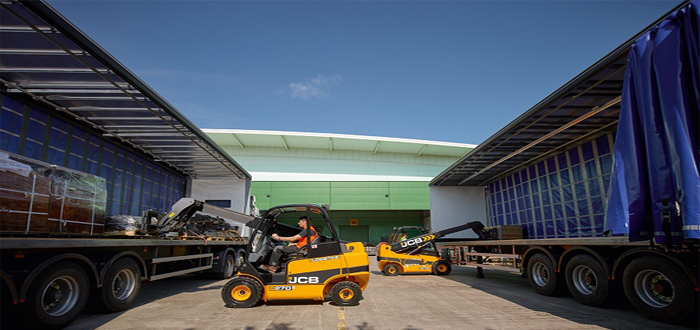-
ROSSLARE EUROPORT TARGETS HEALTH & SAFETY WITH CAMERA TELEMATICS PARTNERSHIP - 2 days ago
-
Landmark Study Reveals Wearable Robotics Significantly Boost Safety and Efficiency in Industrial Environments - July 24, 2024
-
Visku Tackle The Retail Seasonality Challenge One Pallet At A Time - July 22, 2024
-
KAMMAC AND BERGEN LOGISTICS STRENGTHEN FASHION & LIFESTYLE SERVICES IN THE UK - July 19, 2024
-
TENTBOX EXTENDS PARTNERSHIP WITH ARROWXL TO SUPPORT INCREASING DEMAND - July 17, 2024
-
The Perfume Shop improves customer journeys while driving profitability in partnership with Scurri - July 17, 2024
-
ZEROMISSION SECURES £2.3M ($3M) INVESTMENT TO ACCELERATE ELECTRIC FLEETS - July 16, 2024
-
BCMPA CELEBRATES SUCCESS OF 2024 CONFERENCE - July 15, 2024
-
Best of the Best: Jungheinrich Celebrates Triple International Award Win - July 12, 2024
-
GOPLASTICPALLETS.COM CALLS ON NEW CHANCELLOR RACHEL REEVES TO CONSIDER PLASTIC PACKAGING TAX REFORM - July 10, 2024
Warehouse operators urged to make the most of their outdoor space.
With no let-up in the scarcity of good quality warehousing space in sight, occupiers are turning to equipment that allows them to make the maximum use of their existing property assets, says Paul Murray, JCB’s Teletruk general manager
Make the most of the outdoors
It has been well documented that warehousing facilities are in short supply and the acute lack of quality stock allied to the seemingly insatiable appetite of online consumers, is only likely to push demand for new units and rental prices for existing sites ever higher.
It is hardly surprising then, that in a recent survey commissioned by property consultants, Savills, two-thirds of warehouse or distribution centre occupiers questioned said they needed more space.
However, with the amount of speculative building falling – thanks, in part, to planning policies that restrict the construction of new storage facilities – the supply of new-build warehouse space has remained static in most regions.
With no let-up in the scarcity of good quality warehousing space in sight, occupiers are turning to technology that allows them to make maximum use of their existing property assets.
But, while a great deal of thought and planning often goes into the internal design and layout of a store as companies strive to optimise their pallet capacity, the efficient use of outside space is frequently overlooked by logistics planners.
Now though, this is changing as more and more own-account warehouse operators and third party logistics and fulfilment specialists switch on to the importance of optimising every square metre of a site’s external capacity.
With its unique telescopic reach, JCB’s Teletruk has been designed to enable users to leverage their outside storage space.
The Teletruk has the ability to access curtainsided trailers from only one side. This functionality means the amount of floorspace required to load and unload pallets to and from incoming or outgoing vehicles can be slashed by 30% – which, typically, will free up some 32 square metres of yard space per vehicle.
Using Teletruk technology to pick or pack pallets from one side only means that a curtainsider requires just six metres of space within which to be loaded or unloaded. So, trailers can be parked tight to a wall or other form of perimeter boundary –leaving valuable space free in the central yard area for additional storage, extra delivery vehicles or, indeed, tasks such as cross docking .
For example, a leading contractor within the construction and building services industry, had such cramped yard space that, prior to switching to Teletruk technology, it had been necessary to remove all the cars from the company’s staff car park each time a trailer load of goods arrived at or left the site!
Quite simply, with an average trailer measuring some 3 metres wide, unloading or loading with two standard 2.5 tonne counterbalanced forklift trucks required all of the available yard space to enable the lift trucks to manoeuvre safely around the vehicle to load or retrieve or pallets.
However, the introduction of a single Teletruk has allowed the company to reconfigure its goods in and out processes in a far more space efficient way.
Trailers now park up to be processed against a side wall in an area of the yard that would previously have been too narrow for two counterbalanced machines to operate in.
On average, the Teletruk loads or unloads each delivery in around 30 minutes, meaning the massive disruption that impacted upon the company’s working day dictated by the need for staff to move their cars each time a trailer arrived at or left the site, has been eliminated.
And at all sites, loading and unloading a trailer from just one side delivers significant safety and throughput efficiency benefits.
Teletruks make the working environment safer, for example, because less vehicle movements are required to carry out trailer processing tasks and, as outdoor goods yards can be reconfigured to allow trailers to park against a boundary wall, ‘blind’ forklift travel – where a lift truck operator emerges from the side of a parked trailer into what is often a busy area – is eliminated.
In addition, while the location of the mast on a conventional lift truck can compromise forward visibility, the fact that the JCB Teletruk’s telescopic boom is mounted to the side, means the operator has the clearest possible view of the operating environment.
When it comes to throughput, with single side trailer processing – because only one curtain needs to be opened and less truck movements are required – a trailer can be ‘turned around’ in under 30 minutes.
So, if you’ve done all you can to maximise efficiency inside your warehouse, maybe now is the time to consider the gains that can be made by optimising the layout and performance of your outside space.

































